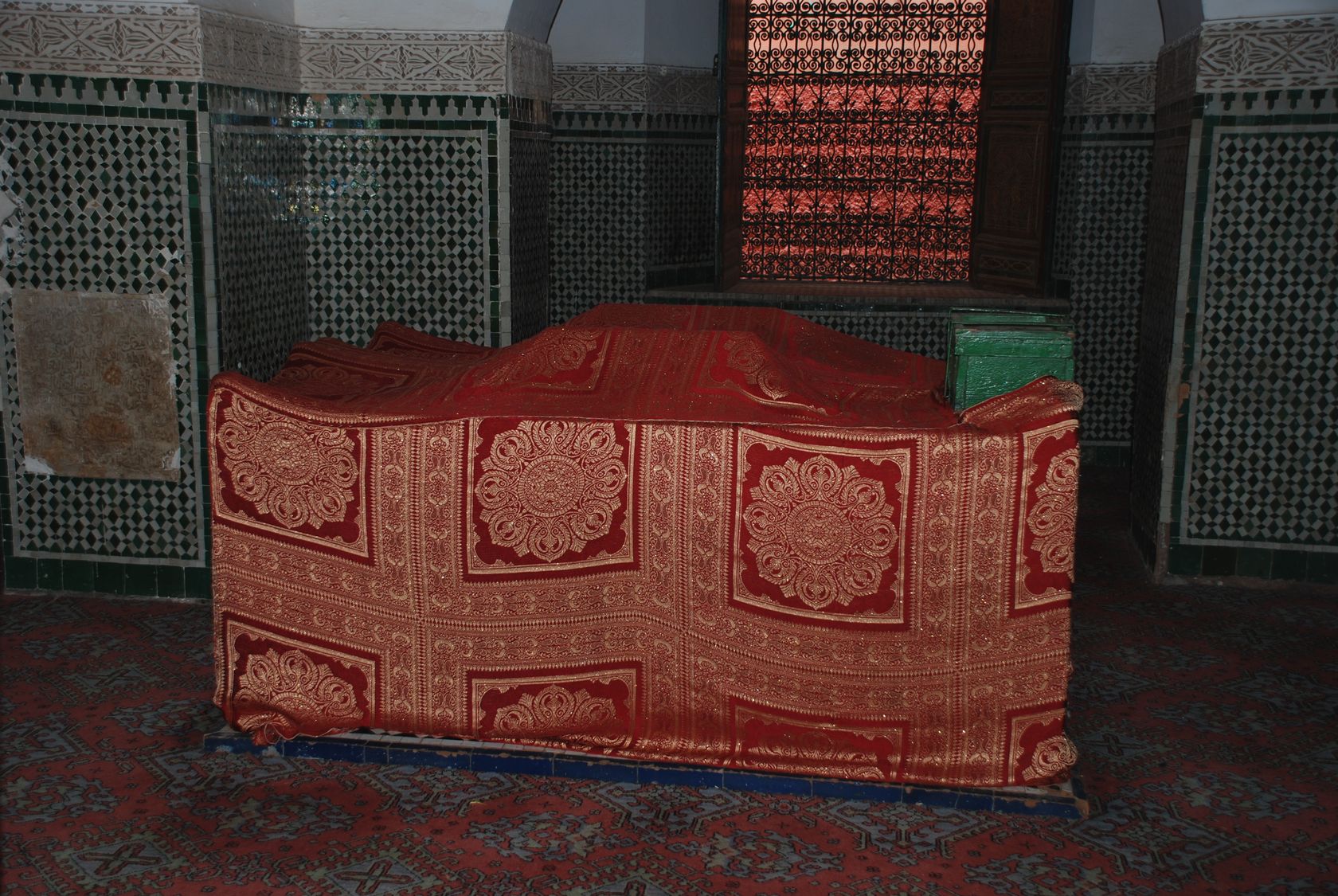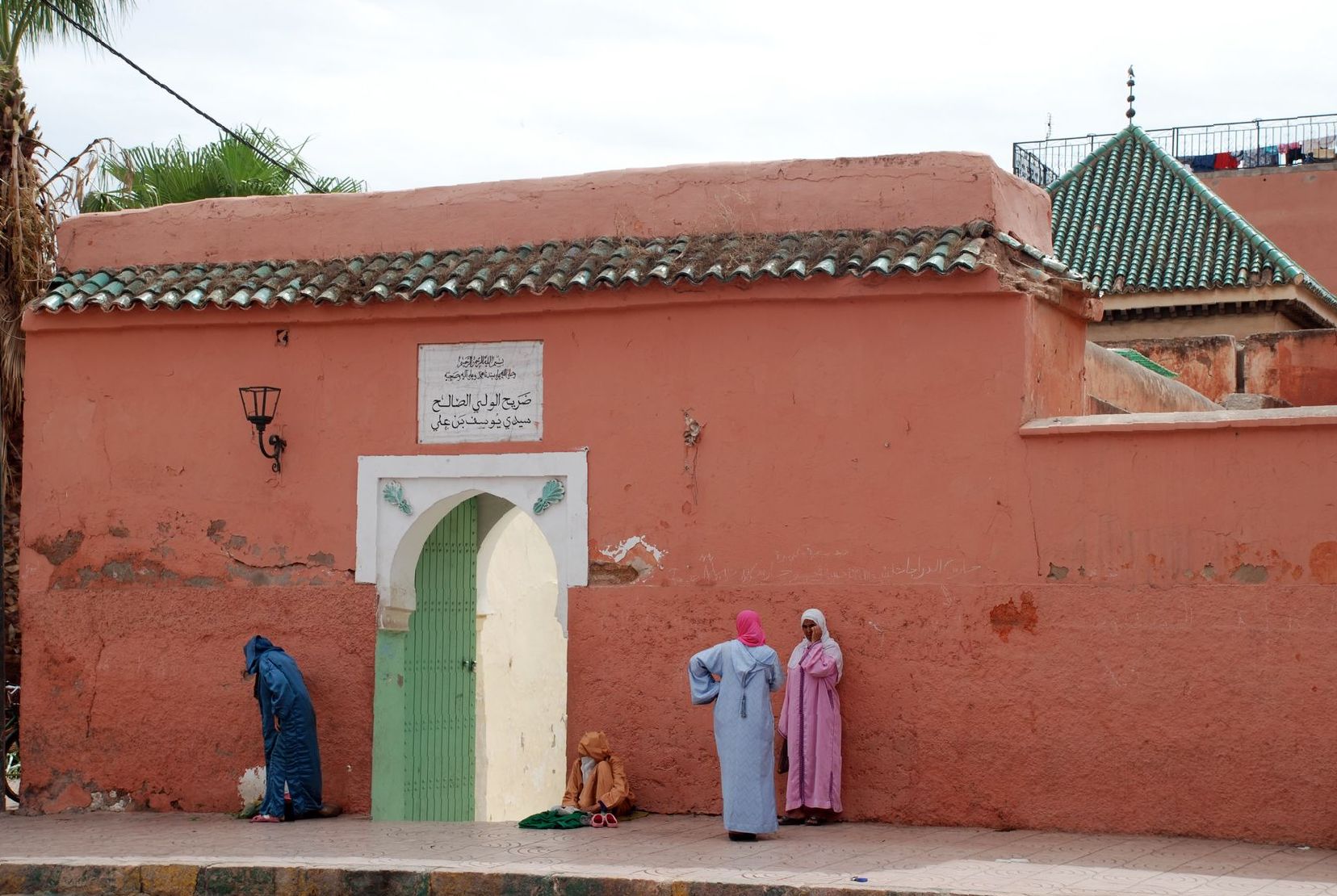|
Seven Saints Of Marrakesh
The Seven Saints of Marrakesh or Patron Saints of Marrakesh () are seven historical Muslim figures buried in Marrakesh, Morocco. Each of them was a famous Muslim judge, scholar or Sufi saint (''wali'') venerated for their piety or other mystical attributes. Their tombs form the basis of a centuries-old annual pilgrimage, a ''ziyara'', during which visitors pray at each of their tombs over the course of seven days. Historical background The tradition of the pilgrimage, or ''ziyara'', to the tombs of the Seven Saints of Marrakesh was created on the initiative of the Alaouite sultan Moulay Isma'il (ruled 1672–1727) in the late 17th century. The motivation for this act was a political desire to exploit the popular influence of the zawiyas (Sufi brotherhood institutions) and to counter the popularity of the "Seven Saints" of the Regraga Berber tribe, which were the basis of another pilgrimage at Djebel al-Hadid near Essaouira at the time. There were also other examples of "Seven ... [...More Info...] [...Related Items...] OR: [Wikipedia] [Google] [Baidu] |
Arabs
The Arabs (singular: Arab; singular ar, عَرَبِيٌّ, DIN 31635: , , plural ar, عَرَب, DIN 31635, DIN 31635: , Arabic pronunciation: ), also known as the Arab people, are an ethnic group mainly inhabiting the Arab world in Western Asia, North Africa, the Horn of Africa, and the western List of islands in the Indian Ocean, Indian Ocean islands (including the Comoros). An Arab diaspora is also present around the world in significant numbers, most notably in the Americas, Western Europe, Arabs in Turkey, Turkey, Arab Indonesians, Indonesia, and Iranian Arabs, Iran. In modern usage, the term "Arab" tends to refer to those who both Arab identity, carry that ethnic identity and speak Arabic as their native language. This contrasts with the narrower traditional definition, which refers to the descendants of the tribes of Arabia. The religion of Islam was developed in Arabia, and Classical Arabic serves as the language of Islamic literature. 93 percent of Arabs are Muslims ... [...More Info...] [...Related Items...] OR: [Wikipedia] [Google] [Baidu] |
Walls Of Marrakesh
The Walls of Marrakesh are a set of defensive ramparts which enclose the historic medina districts of Marrakesh, Morocco. They were first laid out in the early 12th century by the Almoravid dynasty which founded the city in 1070 CE as their new capital. The walls have since been expanded several times by the addition of the Kasbah to the south at the end of the 12th century and by the later extension of the walls to encompass the neighbourhood around the Zawiya of Sidi Bel Abbes. The Gates of Marrakesh were for the most part established since the original Almoravid construction of the city walls but most have been modified during later periods. Other gates were also added when the Almohads created the Kasbah, which itself has been expanded and re-worked many times since. History Almoravid foundation (11th-12th centuries) Marrakesh was founded in 1070 by Abu Bakr ibn Umar, the early leader of the Almoravids. At first, the city's only major fortification was the ''Ksar al-Haj ... [...More Info...] [...Related Items...] OR: [Wikipedia] [Google] [Baidu] |
Qadi Ayyad
ʿIyāḍ ibn Mūsā (1083–1149) ( ar, القاضي عياض بن موسى, formally Abū al-Faḍl ʿIyāḍ ibn Mūsā ibn ʿIyāḍ ibn ʿAmr ibn Mūsā ibn ʿIyāḍ ibn Muḥammad ibn ʿAbd Allāh ibn Mūsā ibn ʿIyāḍ al-Yaḥṣubī al-Sabtī ar, أبو الفضل عياض بن موسى بن عياض بن عمرو بن موسى بن عياض بن محمد بن عبد الله بن موسى بن عياض اليحصبي السبتي), born in Ceuta, then belonging to the Almoravid dynasty, was the scholar of Maliki fiqh and great imam of that city and, later, a qadi in the Emirate of Granada. Biography Iyaḍ was born into an established family of Arab origin in Ceuta. As a scion of a notable scholarly family, ʿIyad was able to learn from the best teachers Ceuta had to offer. The judge Abu ʿAbd Allah Muhammad b. ʿIsa (d. 1111) was ʿIyad’s first important teacher and is credited with his basic academic formation. Growing up, ʿIyad benefited from the traffic of sc ... [...More Info...] [...Related Items...] OR: [Wikipedia] [Google] [Baidu] |
Bab Aghmat
Bab Aghmat () is the main southeastern gate of the medina (historic walled city) of Marrakesh, Morocco. Description The gate originally dates back to around 1126 when the Almoravid ruler Ali ibn Yusuf built the first walls of the city, but it has been modified since this time. It was named after Aghmat, the early capital of the Almoravids before Marrakesh, which lay in this direction (i.e. to the south/southeast). The gate may have also been called Bab Yintan, though this is uncertain and this name may have referred to another nearby gate which has since disappeared. Like other Almoravid gates of the city, it has been significantly modified since its initial construction. Originally, it most likely consisted of a bent passage which effected a full 180-degree turn, forming a symmetrical structure around the axis of the wall: one entered from the west through a bastion on the outer side of the city wall, passing through a roofed vestibule, then exited westwards from the bast ... [...More Info...] [...Related Items...] OR: [Wikipedia] [Google] [Baidu] |
Sidi Yusuf Ibn Ali Sanhaji
Sidi Yusuf ibn 'Ali as-Sanhaji () is a wali (Muslim mystic or saint) who was born in Marrakesh, Morocco and died there in 1196 CE. He is considered one of the Seven Saints of Marrakesh, and one of the administrative divisions of Marrakesh is named after him. Biography Yusuf ibn 'Ali was born in Marrakesh to a family of Sanhaja Amazigh origin and lived in the city his whole life. He studied under Sheikh Abu 'Usfur. He was afflicted at a young age with leprosy, for which he was allegedly banished from his family and from living in the city. He took up residence in a nearby cave or in a hollow that he dug himself, in the lepers' quarter outside the southern city gate of Bab Aghmat. Despite his ill health, he lived longer than anyone expected and many began to believe he possessed powers to resist hunger and disease. Locals came to visit him in his cave seeking guidance, and he came to be known also as ''Mul al-Ghar'' (meaning roughly "Man of the Cave"). He died in 1196 CE and was ... [...More Info...] [...Related Items...] OR: [Wikipedia] [Google] [Baidu] |
Mecca
Mecca (; officially Makkah al-Mukarramah, commonly shortened to Makkah ()) is a city and administrative center of the Mecca Province of Saudi Arabia, and the Holiest sites in Islam, holiest city in Islam. It is inland from Jeddah on the Red Sea, in a narrow valley above sea level. Its last recorded population was 1,578,722 in 2015. Its estimated metro population in 2020 is 2.042million, making it the List of cities in Saudi Arabia by population, third-most populated city in Saudi Arabia after Riyadh and Jeddah. Pilgrims more than triple this number every year during the Pilgrimage#Islam, pilgrimage, observed in the twelfth Islamic calendar, Hijri month of . Mecca is generally considered "the fountainhead and cradle of Islam". Mecca is revered in Islam as the birthplace of the Prophets and messengers in Islam, Islamic prophet Muhammad. The Hira cave atop the ("Mountain of Light"), just outside the city, is where Muslims believe the Quran was first revealed to Muhammad. Vis ... [...More Info...] [...Related Items...] OR: [Wikipedia] [Google] [Baidu] |
Kaaba
The Kaaba (, ), also spelled Ka'bah or Kabah, sometimes referred to as al-Kaʿbah al-Musharrafah ( ar, ٱلْكَعْبَة ٱلْمُشَرَّفَة, lit=Honored Ka'bah, links=no, translit=al-Kaʿbah al-Musharrafah), is a building at the center of Islam's most important mosque, the Masjid al-Haram in Mecca, Saudi Arabia. It is the most Holiest sites in Islam, sacred site in Islam.Wensinck, A. J; Kaʿba. Encyclopaedia of Islam IV p. 317 It is considered by Muslims to be the ''Bayt Allah'' ( ar, بَيْت ٱللَّٰه, lit=House of God) and is the qibla ( ar, قِبْلَة, links=no, direction of prayer) for Muslims around the world when performing salah. The current structure was built after the original building was damaged during the Siege of Mecca (683), siege of Mecca in 683. In Early Islam (other), early Islam, Muslims faced in the general direction of Jerusalem as the qibla in their prayers before changing the direction to face the Kaaba, believed by Musli ... [...More Info...] [...Related Items...] OR: [Wikipedia] [Google] [Baidu] |
Circumambulation
Circumambulation (from Latin ''circum'' around and ''ambulātus ''to walk) is the act of moving around a sacred object or idol. Circumambulation of temples or deity images is an integral part of Hindu and Buddhist devotional practice (known in Sanskrit as '' pradakśiṇā''). It is also present in other religions, including Christianity, Judaism, and Islam. Hinduism In many Hindu temples, the temple structure reflects the symbolism of the Hindu association of the spiritual transition from daily life to spiritual perfection as a journey through stages. Passageways for circumambulation are present through which worshipers move in a clockwise direction, starting at the sanctuary doorway and moving inward toward the inner sanctum where the deity is enshrined. This is a translation of the spiritual concept of transition through levels in life into bodily movements by the worshipers as they move inwardly through ambulatory halls to the most sacred centre of spiritual energy of the d ... [...More Info...] [...Related Items...] OR: [Wikipedia] [Google] [Baidu] |
Bab Doukkala
Bab Doukkala () is the main northwestern gate of the medina (historic walled city) of Marrakesh, Morocco. Description The gate dates back to around 1126 CE when the Almoravid emir Ali ibn Yusuf built the first walls of the city. Doukkala, was that of both a Berber tribe and of a region between Marrakesh and Casablanca today. Unlike many other gates of the city, it has not been subject to major modifications (at least in its floor plan) and retains its original sophisticated bent entrance design from the Almoravid period. The passage inside the gate bends at a straight angle In Euclidean geometry, an angle is the figure formed by two rays, called the '' sides'' of the angle, sharing a common endpoint, called the ''vertex'' of the angle. Angles formed by two rays lie in the plane that contains the rays. Angles are ... twice: one enters from the west, turns south, then turns east before emerging into the city. Today the gate is flanked by other simple openings in the wall ... [...More Info...] [...Related Items...] OR: [Wikipedia] [Google] [Baidu] |
Heterodoxy
In religion, heterodoxy (from Ancient Greek: , "other, another, different" + , "popular belief") means "any opinions or doctrines at variance with an official or orthodox position". Under this definition, heterodoxy is similar to unorthodoxy, while the adjective 'heterodox' could be applied to a dissident. Heterodoxy is also an ecclesiastical term of art, defined in various ways by different religions and churches. For example, in the apostolic churches (the Eastern Orthodox Church, the Roman Catholic Church, the Church of the East, the Anglican Communion, and the Oriental Orthodox Churches), heterodoxy may describe beliefs that differ from strictly orthodox views, but that fall short either of formal or of material heresy. Christianity Eastern Orthodoxy In the Eastern Orthodox Church, the term is used primarily in reference to Christian churches and denominations not belonging to the communion of Eastern Orthodox churches and espousing doctrines contrary to the received Holy T ... [...More Info...] [...Related Items...] OR: [Wikipedia] [Google] [Baidu] |

.jpg)




